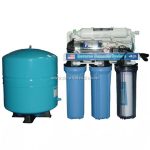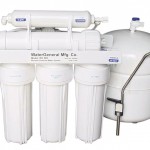What is Reverse Osmosis?
Source: WQA
A water treatment process that removes undesirable materials from water by using pressure to force the water molecules through a semipermeable membrane. This process is called “reverse” osmosis because the pressure forces the water to flow in the reverse direction (from the concentrated solution to the dilute solution) to the flow direction (from the dilute to the concentrated) in the process of natural osmosis.
What does a Reverse Osmosis Water Filter Remove?
Reverse osmosis water filtration systems can remove 90% of total dissolved solids (TDS) from water and can provide the purest water available for your home. Reverse osmosis water filters remove a wide range of contaminants and minerals from your drinking water, including sand, chlorine, fluoride, cryptosporidium, and hexavalent chromium.
Producing Drinking Water Using Reverse Osmosis
Although Reverse Osmosis seems like a complex system it is really a simple and straightforward water filtration process. And it’s not a new process. High-pressure (pump driven) reverse osmosis systems have been used for years to desalinate* water – to convert brackish or seawater to drinking water. Having a better understanding of how a reverse osmosis system works will eliminate the mystery and confusion you may feel when you look at a reverse osmosis system — with its many colored tubes and multitude of filters. Read on to enhance your knowledge of residential reverse osmosis systems.
The most important points to remember:
- All RO Systems work the same way.
- Most RO (Reverse Osmosis) systems look alike.
- All RO Systems have the same basic components.
- The real difference is the quality of the filters and membranes inside the RO.

How the Reverse Osmosis System Works?
Reverse Osmosis is a process in which dissolved inorganic solids (such as salts) are removed from a solution (such as water). This is accomplished by household water pressure pushing the tap water through a semi permeable membrane. The membrane (which is about as thick as cellophane) allows only the water to pass through, not the impurities or contaminates. These impurities and contaminates are flushed down the drain.
For a definition of **Reverse Osmosis.
Ultimately, the factors that affect the performance of a Reverse Osmosis System are:
- Incoming water pressure
- Water Temperature
- Type and number of total dissolved solids (TDS) in the tap water
- The quality of the filters and membranes used in the RO System (see operating specs)
Diagram of a Reverse Osmosis Membrane:

What does a Reverse Osmosis System Remove?
A reverse osmosis membrane will remove impurities and particles larger than .001 microns.
 |
| TYPICAL REJECTION CHARACTERISTICS OF R.O. MEMBRANES Elements and the Percent R.O. Membranes will remove |
||
| Sodium Sulfate Calcium Potassium Nitrate Iron Zinc Mercury Selenium Phosphate Lead Arsenic Magnesium Nickel Fluoride Manganese Cadmium Barium Cyanide Chloride |
85 – 94% 96 – 98% 94 – 98% 85 – 95% 60 –75% 94 – 98% 95 – 98% 95 – 98% 94 – 96% 96 – 98% 95 – 98% 92 – 96% 94 – 98% 96 – 98% 85 – 92% 94 – 98% 95 – 98% 95 – 98% 84 – 92% 85 – 92% |
|
| % may vary based on membrane type water pressure, temperature & TDS | ||
Basic components common to all Reverse Osmosis Systems:
- Cold Water Line Valve: Valve that fits onto the cold water supply line. The valve has a tube that attaches to the inlet side of the RO pre filter. This is the water source for the RO system.
- Pre-Filter (s): Water from the cold water supply line enters the Reverse Osmosis Pre Filter first. There may be more than one pre-filter used in a Reverse Osmosis system. The most commonly used pre-filters are sediment filters. These are used to remove sand silt, dirt and other sediment. Additionally, carbon filters may be used to remove chlorine, which can have a negative effect on TFC (thin film composite) & TFM (thin film material) membranes. Carbon pre filters are not used if the RO system contains a CTA (cellulose tri-acetate) membrane.
- Reverse Osmosis Membrane: The Reverse Osmosis Membrane is the heart of the system. The most commonly used is a spiral wound of which there are two options: the CTA (cellulose tri-acetate), which is chlorine tolerant, and the TFC/TFM (thin film composite/material), which is not chlorine tolerant.
- Post filter (s): After the water leaves the RO storage tank, but before going to the RO faucet, the product water goes through the post filter (s). The post filter (s) is generally carbon (either in granular or carbon block form). Any remaining tastes and odors are removed from the product water by post filtration.
- Automatic Shut Off Valve (SOV): To conserve water, the RO system has an automatic shutoff valve. When the storage tank is full (this may vary based upon the incoming water pressure) this valve stops any further water from entering the membrane, thereby stopping water production. By shutting off the flow this valve also stops water from flowing to the drain. Once water is drawn from the RO drinking water faucet, the pressure in the tank drops and the shut off valves opens, allowing water to flow to the membrane and waste-water (water containing contaminants) to flow down the drain.
- Check Valve: A check valve is located in the outlet end of the RO membrane housing. The check valve prevents the backward flow or product water from the RO storage tank. A backward flow could rupture the RO membrane.
- Flow Restrictor: Water flow through the RO membrane is regulated by a flow control. There are many different styles of flow controls. This device maintains the flow rate required to obtain the highest quality drinking water (based on the gallon capacity of the membrane). It also helps maintain pressure on the inlet side of the membrane. Without the flow control very little drinking water would be produced because all the incoming tap water would take the path of least resistance and simply flow down the drain line. The flow control is located in the RO drain line tubing.
- Storage Tank: The standard RO storage tank holds up to 2.5 gallons of water. A bladder inside the tank keeps water pressurized in the tank when it is full.
- Faucet: The RO unit uses its own faucet, which is usually installed on the kitchen sink. In areas where required by plumbing codes an air-gap faucet is generally used.
- Drain line: This line runs from the outlet end of the Reverse Osmosis membrane housing to the drain. This line is used to dispose of the impurities and contaminants found in the incoming water source (tap water). The flow control is also installed in this line.
We offer an extensive range of under sink RO system to our esteemed customers. Prepared with latest technology, these products are used to purify water. They are highly appreciated for its durability and long life performance. The raw water in this purifier undergoes five stages of water purification system and use 30w power during consumption. With the flow rate 11 – 15 ltr. / hr, these can supply power up to 220 ± 10% Volt. It is widely used in homes, schools, hospitals and offices.
Technical Specifications
Power Supply 220 ± 10% Volt
Installation U/Sink or Wall Mount
Power Consumption 30W (when in use)
Flow Rate 11 – 15 Ltr. / Hr.
Purification 5 Stages
Call us 0333-5204483
reverse osmosis, ro system manufacturer, reverse osmosis system supplier, ro filter factory, Pakistan ro manufacturer, water filters, water purification products





